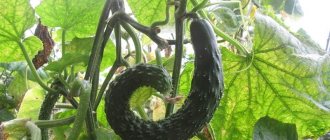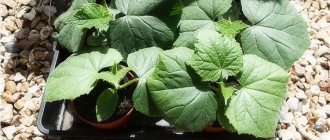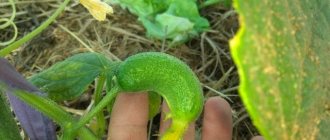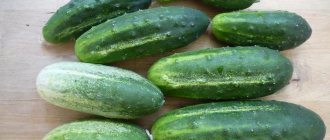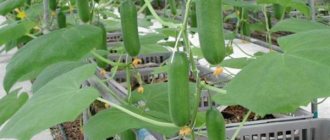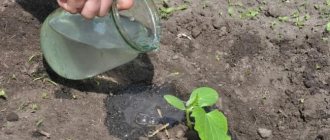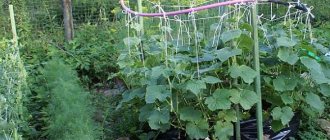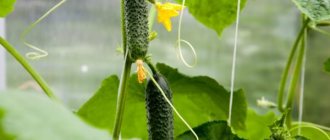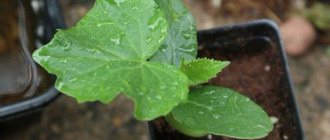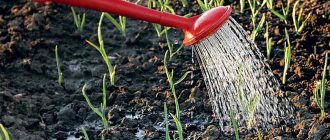First the cucumbers grew loose and empty inside this year. In what causes, care errors and what to do to prevent them from being hollow Let's try to figure it out. Despite the fact that I have been growing them for years, I have not changed the technology, watered them and even fed them. Maybe I chose the wrong variety or they are missing something. These questions concern many gardeners and gardeners. After all, cucumbers are perhaps the most common vegetable on our table after potatoes.
Why are cucumbers empty inside? According to science, this is a developmental defect.
To put it simply, they overfed it with nitrogen, overexposed it to the bush, and in general the weather was not good, either cold and rainy, or too hot.
What to do - when choosing a variety, give preference to parthenocarpic hybrids and regularly feed with potassium and phosphorus!
But more about everything.
Unbalanced diet
The main and most common reason that cucumbers grow empty is untimely feeding. Basically, this is an excess of nitrogen with a lack of phosphorus, potassium and calcium, as well as poor digestibility of microelements.
Secret No. 1! Many gardeners make the mistake of considering mullein to be the best fertilizer. This is not the case for cucumbers. During the flowering and ovary phases, it is the mineral nutritional components that are needed - potassium, calcium, phosphorus, magnesium, iron and many others.
Important! Do not overfeed cucumbers with nitrogen. An overdose occurs even if, during digging, more than 10 kg of manure per 1 sq. m was added to the planting. m, and then fed with urea (urea or ammonium nitrate).
What to do?
When digging when planting, it is better to add compost and wood ash. You can use mineral fertilizers (complex, such as diammophosphate, potassium monophosphate, pure, phosphorus - superphosphate, potassium - potassium sulfate or specialized ones, such as Acrycola).
Important! To quickly correct the situation, you can carry out foliar feeding, i.e. Spray cucumber bushes directly on the leaves.
Calcium is necessary for the development of the root system.
Watch the video : How to help cucumbers with a lack of calcium and microelements (if voids form inside the fruit)
Important! Lack of nutrients can lead to twisted and deformed fruits or yellowing of leaf edges.
Common causes of voids in fresh cucumbers
Having discovered hollow cucumbers with a missing or dry core in the beds, it is important to promptly find out and eliminate the cause. Voids can form as a result of incorrect development of the placenta, where the seed primordia are located. This process is often associated with a violation of the rules of agricultural technology, less often due to third-party factors. It is important to find out the exact cause of hollow vegetables early on to prevent the hollow crop from ripening again.
Unsuitable soil composition
Regardless of where cucumbers are grown - in a greenhouse or in unprotected soil, the correct soil composition is required to obtain a large and healthy harvest. The land in which the crop is grown is a source of useful components for the proper growth of plants and the formation of fruits.
Every gardener needs to ensure that the soil contains a balanced content of essential microelements and other substances that contribute to a good harvest.
It is also important to consider that the soil may contain pathogenic microorganisms that cause the development of diseases. Viral infections provoke disruption of the development of young tissues on plants, as a result of which the process of fruit formation worsens. The described disturbances most often appear in hot weather conditions, when growth processes are activated and proceed faster than in other periods.
When planning to plant cucumbers in a greenhouse, you should treat the soil especially carefully. It is recommended to use purchased soil, which is saturated with useful components and free of harmful bacteria. The soil must be loosened regularly to ensure better air circulation and oxygen penetration directly to the roots. Loosening also simplifies the passage of water to the lower layers.
Fertilizer shortage
Like any vegetable crop, cucumbers need regular feeding throughout the development process. An increased nitrogen content in the soil relative to other components negatively affects the quality of growth. A lack of nutrients leads to a deterioration in the taste of the fruit and the appearance of voids.
See also
Types of warm beds for cucumbers and how to make them yourself
Read
To prevent fertilizer deficiency, it is recommended to use organic fertilizers. When fertilizing the soil with compost, oversaturation of the soil with nutritional components is unlikely, and when using manure, it is important to maintain the permissible volume so as not to harm the seedlings.
The main purpose of fertilizers is to improve soil properties. The soil loses its beneficial characteristics when there is a lack or excessive application of fertilizing. A balanced supply of nutritional components ensures normal growth and development of vegetable crops.
Rare watering
Cucumber is a moisture-loving crop, so regular watering is required for proper growth. Due to insufficient irrigation, the roots cannot absorb the required amount of liquid and microelements from the soil, which leads to the formation of hollow vegetables and a general deterioration in the condition of the plants.
When watering, you need to consider the following rules:
- Irrigation requires warm water (25-28 degrees). Compliance with the temperature regime is required so that excess moisture can evaporate and the required amount reaches the roots.
- In cloudy weather, watering is limited because the roots absorb liquid less well.
- Water is poured under the seedlings in a gentle stream so as not to compact the soil and damage the top layer of roots. The above-ground part of the plants is irrigated in the late evening, after the heat has subsided.
After ripening, cucumbers consist of more than half moisture and enzymes, which are gained through sufficient watering. Irregular watering negatively affects the development of plants, and voids appear inside the cucumbers. To make it easier to control irrigation, you can install a drip system if the seedlings are planted in greenhouse conditions.
Too shaded place in the greenhouse
Cucumber leaves need constant natural light, and the fruits are best grown in slight shade. Strong darkness when planting in a greenhouse does not allow vegetables to develop properly, as a result of which they grow hollow. In addition, due to insufficient lighting levels, fruits lose their taste characteristics and do not grow to the desired size. It is best for cucumbers to grow on a trellis, which allows for optimal conditions.
See also
Description of the African horned cucumber variety Melotria, cultivation and care
Read
Significant temperature fluctuations when growing outdoors
Sudden changes in ambient temperature are common in many regions where gardeners grow cucumbers. This problem often occurs when the atmospheric temperature is high during the day and sharply decreases at night. Constant changes of more than 15 degrees lead to improper formation of vegetables. As a result, a void forms inside, and there are practically no seeds.
When growing in southern areas, temperature changes rarely affect the development of seedlings. In other cases, it is recommended to grow cucumbers in greenhouse conditions to make it easier to provide a stable environment.
Late harvest
Harvesting should be carried out as soon as possible after the vegetables ripen. If you leave cucumbers in the garden beds, they will become overripe, increase in size and form seeds. This is what causes internal voids to appear. The peel of overripe specimens becomes hard, and cucumbers begin to consume water resources from accumulated reserves. Most often, this problem is typical for cucumbers that need pollination.
Feature of the variety
There are varieties of cucumbers that have increased resistance to void formation. These varieties include hybrids labeled F1. Common hybrids that do not form voids are:
- Brawler;
- Marina Grove;
- Green Wave;
- Grasshopper;
- Chistye Prudy.
It is important to consider that it is not advisable to use seeds from hybrid cucumbers of the listed varieties. Hybrids are not capable of transmitting hereditary traits, so to reduce the likelihood of voids appearing, it is better to use new planting material.
Growing hybrid varieties does not guarantee a high-quality harvest. To prevent the formation of voids, it is necessary to provide comprehensive care and regularly follow standard agricultural practices.
Insufficient watering
One of the main reasons for the appearance of looseness and emptiness inside the fruit is improper watering.
Watering should be regular and sufficient. If you don’t water the cucumbers for 3-4 days, the soil becomes quite dry. When you water suddenly and in large quantities, it can lead to tissue rupture, cracks and voids.
Important! Improper watering can also lead to deformed and distorted fruits.
- It is important to water cucumbers every day, in the evening or in the morning, especially if you have a hot climate.
- The water should be warm 25-28 degrees.
- Also, do not forget about loosening, this will allow air circulation at the roots, which promotes rapid growth.
How to water cucumbers correctly, read our article: How to properly water cucumbers in a greenhouse and open ground
Secret No. 2 In order to prevent the formation of a crust on the soil and retain moisture at the roots longer, the holes need to be mulched, possibly with straw or compost.
Preventing the appearance of empty cucumbers by watering
A cucumber is 90% liquid, which means its need for water is extremely high. But it’s important not to overdo it! If you over-water after drying, the cucumbers may grow empty inside.
Watering should be constant and uniform. Left alone in the heat, cucumbers grow their skins to retain moisture. This happens literally due to internal reserves and leads to the appearance of voids. In addition, uneven watering becomes one of the causes of bitterness in cucumbers.
Solution
Drip irrigation system. This could be a drip tape or tube, or it could be a fitted plastic bottle. You can also “lay straw” - mulch the holes with it to protect the soil from cracking. If you use a watering can exclusively, make sure that the top layer of soil always remains moist. Means of preventing drying out are available to everyone - whitening greenhouses, shading bushes.
Cucumber “leprosy with the peel” is especially noticeable in the heat, when the fruits swell more intensely than usual.
Soil features
Why are cucumbers empty in open ground and in greenhouses? The soil in the cucumber bed should be soft and loose. It is impossible to get a good harvest from hard, depleted and sandy soil. The main thing: after watering you need to loosen it, since air circulation at the roots is the key to success.
Ideally, for garden beds, it is better to use purchased soil saturated with fertilizers and all the necessary components, such as:
- compost or humus - add 5-8 kg per 1 square meter of bed.
- wood ash at the rate of 100-200 g per 1 sq. m.
- You can apply mineral fertilizers before planting, such as: nitroammophoska (2 tablespoons per 1 sq. m), superphosphate, urea, ammonium nitrate, potassium sulfate.
Organic or mineral fertilizers can be applied directly into the prepared holes during planting.
How to properly prepare the soil and plant cucumbers, read our articles:
Growing cucumbers in a polycarbonate greenhouse: when and how to plant
Planting cucumbers with seeds in open ground: rules for sowing and growing
Useful tips for growing cucumbers
If you are just getting started with something like growing cucumbers, useful tips on this matter will come in handy. You can plant cucumbers either directly in the ground or by preparing seedlings. For an inexperienced summer resident, the option with seedlings will be more convenient.
Landing
You need to plant cucumber seedlings in separate small containers - cups or containers. It is better to purchase ready-made soil for this in the store. When the seedlings grow, move them to open ground. Place the bushes at a distance of 15-20 cm from each other.
Make sure there is no threat of frost, otherwise your bushes will freeze!
Cucumbers will need special supports because this plant branches. Prepare and install pegs in advance.
Care
When the cucumber strands become more or less long, tie them to the supports that you installed in the greenhouse. If you notice that the bushes are planted too often, you can safely thin them out: the plants should have enough space to grow and develop.
Once every 3-4 weeks it is better to feed the plants with natural fertilizers. Compost is great for this. Inspect cucumbers for harmful insects. If you find pests, you need to get rid of them. Depending on the species of beetles, use the products. It is better, first and foremost, to try products with natural composition. Carefully study the description of the drug and how to use it.
Harvesting
Harvest on time. To eliminate bitterness and voids, and also to enjoy fresh small cucumbers, collect vegetables every 3-4 days. If we are talking about July and especially August, you can visit the greenhouse every other day. As a rule, this is an active time for cucumber growth: warm nights promote fruit growth.
Growing cucumbers is not an easy process. But with proper planning and taking into account all the subtleties, you will get a harvest that will be pleasant to eat both fresh and preserved for the winter. By taking all preventive measures and carefully caring for the bushes, you can avoid the appearance of voids inside the vegetables. Gradually you will gain the necessary experience and learn to anticipate all possible difficulties in advance.
Diseases of cucumbers, mainly viral
The reason for the appearance of voids can be infection of the bushes with viral diseases.
For example, viral necrosis can reduce the yield of cucumbers by 70% or leave us without a harvest at all. Cucumbers are often infected with the tobacco mosaic virus. In this case, it is necessary to immediately treat the bushes with iodine solution, the concentration is described in the article
You can use Antichlorosin, Mik-Reacom or iron sulfate (50 g per 10 liters of water). Continue processing until the leaves turn green.
More details about diseases of cucumbers in the article: Main diseases of cucumbers, their description and methods of treatment with photo examples
You can increase the immunity of plants in a greenhouse (soil) with the help of growth regulators ( Zircon, Fitoverm, Fitosporin). More details about each in our articles.
By observing crop rotation, choosing varieties that are resistant to viruses and using the above-mentioned drugs, you will definitely not be left without a harvest.
What to do if cucumbers are empty inside, and how to get rid of the problem
Anyone, even an experienced gardener, may encounter the problem of hollow fruits. First of all, you need to identify the cause, then begin to eliminate it. The presence of viral diseases can be understood by the formation of unnatural spots on the leaves or premature drying of the vines. The diseased plant must be removed so as not to infect neighboring plantings.
But what to do when the harvest has already been harvested, and most of the fruits inside are empty? In this case, canning or pickling would be an excellent solution. First you need to pour slightly salted water over the fruits and let them stand for several hours. You can check the readiness for preservation using a toothpick by piercing the fruit. Cucumbers should absorb as much liquid as possible, and salt will help retain it. Pre-soaked fruits will be crispy and elastic, and the preparations will not deteriorate.
Variety selection
Therefore, if you plant, then use familiar varieties and good hybrids, purchased in a trusted place from trusted manufacturers.
Secret #3 Don't want empty cucumbers? Do not plant early and pollinated varieties. With short daylight hours, they are physiologically unable to form full-fledged fruits.
If you plan to choose parthenocarpic hybrids for autumn rotation, which do not depend on the length of daylight hours, medium or late ripening. And well branched: the main vine with a short daylight hours reduces the growth force.
Juicy, crispy F1 hybrids that do not form voids in the fruits:
- Grasshopper,
- green wave,
- Petrel,
- Buyan,
- Makar,
- Dragonfly,
- The hit of the season,
- Okhotny Ryad,
- Marina Grove.
Trick! If you picked cucumbers and they turned out to be hollow inside, but you need to preserve them, use this advice: soak in salted water before canning for 2-3 hours. The concentration of the solution per 1 liter of water is 1 teaspoon. A spoonful of salt. So that they are saturated with water. And the salt will hold it in. And for the winter there will be cucumbers - not soft, without voids. That's the whole secret.
Watch the video : How to grow a cucumber without voids
Advice from experienced housewives
The scientific calculations are complemented by advice from “kitchen practitioners”, proven over the years :
- Even hollow cucumbers can be pickled if you first soak them in salted water. This “rehearsal” will speed up the fruit’s absorption: the tissues will absorb the salt, and it will retain moisture inside the cucumber.
- A cold ice bath will help “bring to life” cucumbers that are not quite fresh and soft. The vegetables will become dense and crispy and will not lose their shape during pickling.
- You can reduce the risk of voids forming in pickles by piercing each fruit.
- For brine, it is better to choose clean well or spring water. Hard water pipes can be settled, but not filtered!
- Rock salt has proven itself well in home preparations. It is better to leave fashionable Himalayan, iodized or sea for other dishes.
- If barrels are used for pickling, oak or alder are preferable. These types of wood do not absorb brine, do not rot, and give cucumbers a pleasant aroma.
It can be useful:
How to store pickles in an apartment
What to do if the cucumbers in the jar become cloudy
Why do jars of cucumbers explode?
Which food to choose?
For normal fetal growth, it is necessary to add various nutrients.
Sometimes their quantity is not enough, so voids appear inside the cucumber.
It's all due to unbalanced nutrition during active development.
As a result, the crop receives more nitrogen than other nutrients.
This problem can arise due to excessive fertilization of the soil with manure or feeding the bushes with saltpeter or urea.
It is best to use compost by mixing mineral fertilizers into it.
Another solution is to use ash for feeding. It is applied to the entire surface of the bushes. It can be carried out unscheduled.
Fighting hollow cucumbers
As soon as you have tasted the fruit and saw the emptiness inside, begin to act. There is no need to pick off all the greens and throw them away, the situation can be corrected. To do this, provide fruit-bearing plants with comfortable conditions for growth, and the problem will solve itself. To do this, follow several steps:
- normalize watering. To moisten the soil, use chilled water, never ice water. Pour in a thin stream, there should be no splashing, otherwise you can damage the fragile root system. Spray the above-ground part in the evening, a few hours before sunset;
- thin out the plantings. If you see that the bushes are already interfering with each other, the strong are crowding out the weak, then pull out some of the plantings. If you thin out the vegetables in time, this will not negatively affect further productivity, but the cucumbers will have enough lighting;
- feed the crop. The most effective fertilizing is compost in combination with urea. When applied, they improve soil quality and increase fertility.
On a note! If the greenhouse is located on the dark side, then install ultraviolet lamps between the beds for additional illumination.
